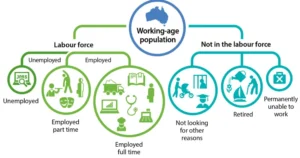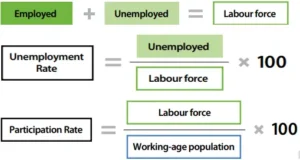Unemployment: Meaning and Types
- Unemployment is not synonymous with joblessness. The International Labour Organization (ILO) defines unemployment as being out of a job; being available to take a job; and actively engaged in searching for work. Therefore, an individual who has lost work but does not look for another job is not
- India’s working-age population is defined as the people between 15 and 64 years of age.
- The labour force comprises all those persons who were either ‘working’ and those who were ‘seeking or available for work’, while the workforce comprises of the former.
- Those neither employed nor unemployed — such as students and those engaged in unpaid domestic work — are considered out of the labour force.
- The unemployment rate is measured as the ratio of the unemployed to the labour force. The unemployment rate could also fall if an economy is not generating enough jobs, or if people decide not to search for work. Measuring unemployment in India is difficult due to the informal nature of jobs.


Types of Unemployment
- There are different Types of Unemployment depending on the nature, causes, and duration of unemployment. Unemployment is broadly classified in following categories.
Read also: India’s Trade Deficit with China | UPSC
a) Cyclical unemployment
- When there is an economy-wide decline in aggregate demand for goods and services, employment declines and unemployment correspondingly increases.
-
- Therefore, it is sometime referred to as ’demand deficient unemployment‘.
-
- Cyclical unemployment occurs with changes in economic activity over the business cycle.
-
- During an economic downturn, a shortfall of demand for goods and services results in a lack of jobs being available for those who want to work.
-
- Cyclical unemployment is often described as being medium term in nature (one to 12 months).
b) Structural unemployment
- This kind of unemployment occurs when there is a change in consumer demand and technology in the economy.
-
- For instance, when computers were introduced, many workers were dislodged because of a mismatch between the existing skills of the workers and the requirement of the job.
- Although jobs were available, there was a demand for a new kind of skill and qualification. So, persons with old skills did not get employment in the changed economic regime, and remain unemployed.
-
- Structural unemployment tends to be longer lasting than other types of unemployment.
-
- This is because it can take a number of years for workers to develop new skills or move to a different region to find a job that matches their skills.
-
- In contrast to cyclical unemployment, structural unemployment exists even when economic conditions are good.
-
- In theory, this type of unemployment should not directly influence wages or inflation and is best addressed through policies that focus on skills and the supply of labour.
-
c) Frictional unemployment
- This types of unemployment refers to a transition period of looking for a new job, for different reasons, such as seeking a better job, being fired from a current job, or having voluntarily quit a current job.
- The period of time between the current to a new job is referred to as frictional, or temporary unemployment.
- This type of unemployment is generally shorter term (less than one month).
- Frictional unemployment is likely to occur at all points of the business cycle and, like structural unemployment, may not influence wages or inflation.
d) Seasonal unemployment
- Seasonal unemployment, a type of frictional unemployment, occurs in specific activities or occupations which are characterized by seasonal work.
- An example of seasonal unemployment is the joblessness during non-cultivation in rural areas.
e) Disguised unemployment
- When marginal physical productivity of labour is zero or sometimes it becomes negative is termed as disguised unemployment.
- This is the condition when more people are hired or employed to do work that can be easily done by a lesser number of people.
- In this, there would be no negative effect or impact on their productivity even if some people are removed.
- g.: If the cultivation of one-hectare land requires 5 workers but 8 are working here 3 extra employees or workers are disguised as unemployed as they are not adding to productivity.
f) Natural rate of unemployment
- The sum total of frictional and structural unemployment is referred as the natural rate of unemployment.
g) Open unemployment
- Open unemployment arises when a person, voluntarily or involuntarily, keeps himself or herself out of consideration for certain jobs.
h) Working poor
- Working poor is defined as a situation when individuals or households, in spite of being employed, remain in relative poverty due to low levels of wages and earnings.
Read also: Inheritance Tax: Meaning, Need, Significance and Challenges | UPSC
References:
- https://www.rba.gov.au/education/resources/explainers/unemployment-its-measurement-and-types.html#:~:text=delay%20their%20retirement.-,What%20are%20the%20main%20types%20of%20unemployment%3F,way%20of%20thinking%20about%20unemployment.
- https://www.forbesindia.com/article/explainers/unemployment-rate-in-india/87441/1
- https://www.thehindu.com/business/Economy/how-unemployment-is-measured/article67278546.ece

